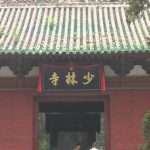Shaolin Kung Fu (少林功夫) Posted by Stephen on Jul 19, 2011 in Culture
 Shaolin kung fu or 少林功夫 (shàolín gōng fu) is China’s oldest institutionalized form of martial arts, and includes both internal (breathing and meditation) and external (physical activity) practices. For centuries, people from all over China (and the world) have flocked to the Shaolin Temple (少林寺) to study the esoteric practices of these monks. You’ll recognize them by their bright orange robes, wiry frames and their bald heads.
Shaolin kung fu or 少林功夫 (shàolín gōng fu) is China’s oldest institutionalized form of martial arts, and includes both internal (breathing and meditation) and external (physical activity) practices. For centuries, people from all over China (and the world) have flocked to the Shaolin Temple (少林寺) to study the esoteric practices of these monks. You’ll recognize them by their bright orange robes, wiry frames and their bald heads.
Shaolin is synonymous with kung fu, and rightly so. After all, Shaolin kung fu has been there since the beginning of China’s foray into the martial arts. While Shaolin kung fu is highly respected among martial arts, its popularity comes from a recent revitalization of kung fu culture within China and the rest of the world. Sure Shaolin Kung fu is big when you have the internet, DVDs and trans-continental flights, but what about the Shaolin Kungfu that was? This is the legend of how Shaolin came to be before the corny 70s music, paper-mache-special-effects and comically dubbed-over English tracks…not that I’m complaining about those things.
The “History” of Shaolin
While there is a great deal of mysticism and legend behind the origins of Shaolin Kung fu, the actual historical events that led to the institutionalized form of Kung fu today are somewhat hazy. Still, like most Chinese legends, they are both enjoyable and telling about a culture, so here’s the abridged version:
According to legend, Bodhidharma, a 5th Century Buddhist credited for the introduction of Zen to China, visited the fledgeling temple and “faced a wall for nine years, not speaking for the entire time”. After his nine years of staring (rather intensely I guess) were complete the story goes that a hole had been pierced in the wall caused by his lazer-like stare and focus. During that time he supposedly left behind a book, the “Muscle Tendon Change Classic”, which chronicled his mastery of mind over body techniques. With that, the Shaolin monks began incorporating methods learned from the Bodhidharma’s books. From there, Shaolin culture took on a whole new life of its own.
The monks practiced these techniques at great lengths with perfection being their only goal. As centuries passed, word of the monks fighting skills spread throughout China with royal families, feuding clans and the Emperor (皇帝) seeking the protection and backing of Shaolin monks. When the dust settled, it appeared he who had the backing of Shaolin, had the backing of a dangerous military force–one that was revered and feared by its enemies.
In the many centuries that followed (up til about the 17th Century) an era of peace crept over the temple. The Shaolin monks, either by choice or by the unwillingness of their enemies to go at it with super soldiers, didn’t fight outside of the monastery walls or engage in military actions. Instead the monks looked inward, focusing on mastery of the body–even those weird parts–at all costs. And with that I segue you to “Iron Crotch”:
Did I mention how awesome kung fu is? Now imagine that for almost every body part as there is a Shaolin style of “Iron [blank]”. Don’t believe me? Just go to youtube and type in “shaolin iron” and see what you get. I apologize for those who stumble upon “iron testicles” in advance (not really). After all, it’s all about hardening your body and steeling your mind…or in this case, your head:
But I digress…where did I leave off? Oh yeah…
By the 17th Century, Shaolin kung fu was famous throughout the lands (after seeing that I understand why) and the monks began placing emphasis back on true fighting styles of actual self defense moves, including many of these “Iron Body” techniques. Yet by the early 20th Century, ancient Chinese culture was seen as an impediment to modernist movements (I’ll chose my words carefully here so as not to get the “great firewall of China” from 哥哥 or “big bro”) and the Shaolin Temple, along with it’s culture was put on hold.
Luckily for us fans of kung fu, the 1970s ushered in a a revitalization kung fu with a huge emphasis on Shaolin kung fu. This happend shortly following the 改革开放 or “Open Door Policy” in which the sport of kung fu once again became a lucrative and entertaining export (especially with the prevalence of Television). China’s love for Shaolin fighting styles was reborn again and has thrived throughout the past 4 decades.
Follow Steve on twitter: @seeitbelieveit

Build vocabulary, practice pronunciation, and more with Transparent Language Online. Available anytime, anywhere, on any device.
About the Author: Stephen
Writer and blogger for all things China related. Follow me on twitter: @seeitbelieveit -- My Background: Fluent Mandarin speaker with 3+ years working, living, studying and teaching throughout the mainland. Student of Kung Fu and avid photographer and documentarian.





Comments:
Steven C. Poling Jr.:
“Kung Fu” is the greatest English mistranslation of any Chinese words. 功夫(gong1fu)simply means (physical) skills. Even if someone is great at chopping vegetables or sewing some mittens, you could say “哦,你的功夫很好。"
Martial Arts = 武术(wu3shu4)。
Brigitte Norris:
Thank you for all the great vidieo’s I love all your great photos
ShaoLin Shi Xing Ming:
Learn Kung Fu in the Shaolin Temple
Learn Kung Fu in the real Shaolin Temple in China with Shaolin monk Wang Xin Peng. Call 661-472-1884 (USA) 0086-013838312721(China)to find out how.
http://www.traininshaolin.com
shaolinmonk_gongfu@hotmail.com